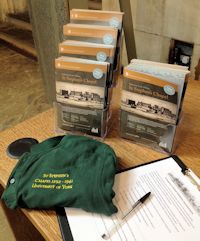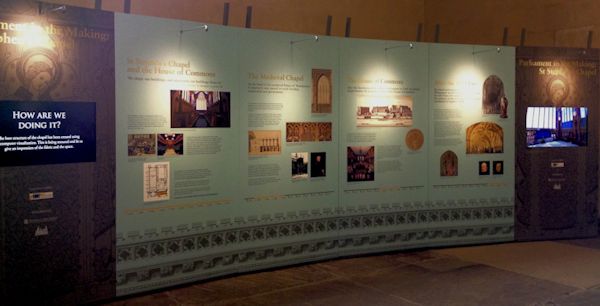Reimagining and recreating the past at Westminster Hall
Posted on 19 August 2015

Lizzie Atkinson
MA in Renaissance and Early Modern Studies, 2015
As I entered Westminster Hall, the temporary home of the St Stephen’s Chapel exhibition, for the first time, I felt immediately dwarfed by the sheer size of the space. The lofty 800-year-old hammer beam roof and beautiful stained glass windows certainly make an impact. It’s easy to see why the space was used as the Royal Court for so many years – it conjures up all that is associated with the King: majesty, power and grandeur.
This would be my home for the next few weeks as I undertook my role as an intern with the Virtual St Stephen’s Project at Westminster Palace. The internship was designed to work alongside those involved in the AHRC-funded project on St Stephen’s Chapel, Westminster, assisting the research team, both at the University of York, and the staff at Westminster Palace itself. My brief was to present the project to the public and gather information about visitor engagement and their interaction with the exhibition. I also sought to gauge the overall impact of the exhibition on the way that visitors understood St Stephen’s Chapel and its importance to the political, social and religious history of the UK.
Ironically, given the aims of my internship, perhaps the most immediate and obvious challenge of my role was one of immediate public impact and engagement; I remember thinking how could I engage the public in the rich history that St Stephen’s had to offer, whilst standing within the splendour of Westminster Hall? How could I interest them in the project when I couldn’t physically take them to see the Chapel itself after a fire destroyed it in 1834?

However it soon became apparent that my project uniform, corpus of material and leaflets as well as the eye-catching exhibition panels and video detailing the virtual reconstruction of the Chapel itself were more than enough to spark the public's initial interest. As I gave them an outline of the project and its aims, I was able to stimulate this interest further. I soon realised that very few people had prior knowledge of St Stephen’s Chapel, and those who found it a familiar name, were more likely referring to the current St Stephen’s Hall, which came seven centuries after St. Stephen’s Chapel was built, and stands on the foundations of the Chapel. To overcome this hurdle I found that it was easiest to walk and talk, taking the visitors up into St Stephen’s Hall whilst explaining the architecture and history of the Chapel and its different uses over time. Standing in St Stephen’s Hall with the tour groups lined up on the seats facing each other, it was easy to imagine how the space would have been used when it was once the House of Commons.
For many of the visitors, this was their first time at Westminster Palace and their first time learning about St Stephen’s Chapel. It was a privilege to be able to share with them this part of British history and to learn from them how they felt about the project and its importance. With my fellow interns, I collected over seventy questionnaires from visitors. More than three quarters of respondants noted how the project had significantly increased their understanding of the Chapel and its history, as well as how historical research could be used to gain insights into the past. I lost count of the number of times the exhibition was hailed as ‘very interesting and informative’, ‘jolly good’ and ‘a real surprise’.
My internship was also a truly valuable and rewarding experience. I would highly recommend the IPUP internship to any History student at the University of York.

